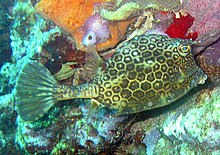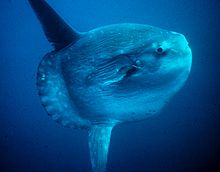Tetraodontiformes
[2] In 1940 Berg first used the term Tetraodontiformes for this order and this name is the currently accepted name as it follows the International Code of Zoological Nomenclature rule that a name for a family or higher taxa must have its root based on the type species of that grouping.
[7] Tetraodontiformes suffixes ifirmes, meaning "in the form of",[8] onto the genus name], Tetraodon, of the type species of Tetraodontidae, the best known and most widely distributed family in the order.
[9] The oldest tetraodontiforms are the extinct suborder Plectocretacicoidei from the Late Cretaceous (Santonian to Campanian) of Italy and Slovenia, both in the former Tethyan region.
The tetraodontiform strategy seems to be defense at the expense of speed, with all species fortified with scales modified into strong plates or spines[11] – or with tough, leathery skin (the filefishes and ocean sunfish).
Another striking defensive attribute found in the pufferfishes and porcupinefishes is the ability to inflate their bodies to greatly increase their normal diameter; this is accomplished by sucking water into a diverticulum of the stomach.
Many species of the Tetraodontidae, Triodontidae, and Diodontidae are further protected from predation by tetrodotoxin, a powerful neurotoxin concentrated in the animals' internal organs.
The Molidae are conspicuous even within this oddball order; they lack swim bladders and spines, and are propelled by their very tall dorsal and anal fins.



